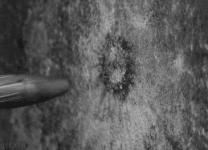From: Victor Rocales
Sent: Wednesday, April 17, 2013 11:34 AM
To: 'Trade Commodities'
Subject: RE: Metal Detectors
Hi Ed,
How many square meters is the whole lot?
The P.I. can still be used to located
the prospect deposit even if there are steel bars, I usually place the antenna
1 foot above the ground to discriminate the steel bars, from the actual signal
coming from the precious deposits. P.I. is not affected by cement, gravel or
water. As long as the electromagnetic wave concentration is accumulated on top
of the deposits. The signal can still be traced by the P.I. gadget.
As long as we can insert the 4 copper probes into the ground or
coral rocks we can still use the GRM for locating the prospect deposits.
I’m using a very low frequency for my GRM ( around 45 hertz ) At this frequency
the electric current travels deeper into
the ground and not along the surface of the ground.
Higher frequency electric currents travel along the surface of the ground.
I have experienced with this kind of situation in northern Cebu. The whole area
Is a solid coral rock formation. The place is 500 meter away from the shoreline or
beach. The area is 20 ft above sea level. My client said that the deposits are right
beneath house. So I placed and inserted the 4 copper probes just 2 meter away
from each of the 4 solid foundation of the house, The 4 copper probes where
separated from each other, with equal distances. The house was enclosed with
the 4 copper probes. Then I started operating the GRM ( ground resistivity meter ).
The result were as follows. The 3 sides of the of the house registered high
resistance ( low ground conductivity ). Then one side registered
low resistance ( high ground conductivity ), so I went to the side of the house
with low resistance. I did not enter the house, I just went along the side of the
house and use my P.I. gadget for actual pinpointing of the deposits. I found
one strong signal coming from the ground 2 meters away from the house, on
one side. So I transferred the other probes outside the house. So the 4 probes
Now is located out side of the house. This time the house is no longer enclosed
With the 4 copper probes. The 4 copper probes is now enclosing their backyard.
I started again operating the GRM, I found a very low resistance
( high ground conductivity ) on the backyard of the house.
I started again using my P.I. gadget for pinpointing. I found another 2 deposits
On their backyard. Now I was able to find a total of 3 prospect deposits in their
Backyard forming a triangular formation, each deposit is place 20 ft away from
Each other with equal distances forming a perfect triangle. So meaning to say even
If there was a house and with all its steel bars. The precious metal was able to
Produce a low resistance ( high ground conductivity ) on their backyard, much
Higher ground conductivity compared to the area of the house.
Then I used the GRM to get an approximated or estimated depth of the deposits.
To my estimate, it was around 35 ft below the surface. 35 ft below the solid coral
rocks. 15 feet below sea-level.
Vicrocs
---------------------------------------------------------------
From: Trade Commodities
Sent: Tuesday, April 16, 2013 7:23 PM
To: Victor Rocales
Subject: RE: Metal Detectors
Hi,
The surface of the area for detection of Au is coral rock on a cliff 7.5 meter up
from the high tide line where the sea touches on high tide.
There is a house built on it and the gold is supposed to be buried under the house.
The house floor is concrete, sand and gravel mix with round bars.
The whole property lot is cemented and there are neighbors on each side, one side is
the cliff / sea and behind is a concrete street. the 3 sides have concrete hollow block
walls.
Question:
1. Can the GRM or PI detectors be used for detecting on coral rock and will the cement
floor and steel bars affect its accuracy?
Thanks,
Ed




